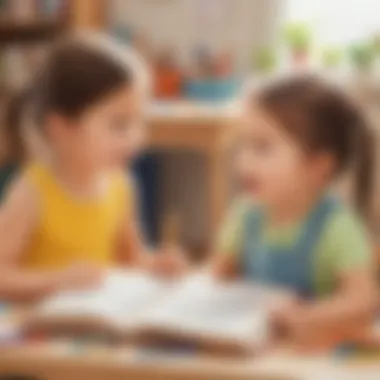Unlocking the Power of Sound Learning in Kindergarten for Enhanced Cognitive Development


Fun Activities Ideas
Engaging young children in sound learning activities can be both fun and educational. Here are some exciting ideas to incorporate into your kindergarten curriculum:
- Indoor Activities: Set up a sound station with musical instruments like drums, xylophones, and tambourines for kids to explore different sounds and rhythms. Encourage them to create their own musical compositions.
- Outdoor Adventures: Take the learning outside with a nature sound scavenger hunt. Kids can listen for birds chirping, leaves rustling, or water flowing, enhancing their auditory awareness.
- Arts and Crafts: Integrate sound into artistic expressions by creating sound-themed art pieces. Utilize materials like bells, beads, and paper tubes to make sound sculptures.
- Science Experiments: Conduct sound experiments such as exploring how sound travels through different mediums or creating DIY musical instruments to understand vibrations and frequencies.
- Cooking and Baking: Engage children's sense of sound in the kitchen by baking items that involve auditory cues, like crackling cookies or sizzling vegetables.
Educational Games
Making learning enjoyable through interactive games can significantly impact a child's understanding. Here are some game ideas to reinforce sound learning:
- Math and Logic Games: Incorporate math games that involve auditory elements, such as counting rhythms or creating patterns with sound.
- Language and Vocabulary Games: Enhance vocabulary retention with word association games that include sound cues or phonics matching activities.
- STEM Activities: Integrate sound into science, technology, engineering, and math activities by exploring sound waves, frequencies, and their application in daily life.
- History and Geography Puzzles: Connect sound learning to historical events and geographical locations through interactive puzzles and challenges.
- Interactive Learning Apps: Utilize educational apps that focus on sound recognition, phonetics, and language development to provide a well-rounded learning experience for children.
Seasonal and Holiday Activities
Aligning sound learning with seasonal and holiday themes can make the educational journey more festive. Here are some ideas to infuse sound into seasonal celebrations:
- Valentine's Day Crafts: Create sound-inspired Valentine's Day crafts like heart-shaped drums or musical love notes to engage children in themed activities.
- Halloween Costume Ideas: Encourage sound exploration through costume creation by incorporating elements that produce interesting sounds, such as bells or rattles.
- Thanksgiving Cooking Projects: Involve children in preparing Thanksgiving dishes that involve auditory sensations, like crunchy nuts or bubbling soups.
- Christmas Decorations: Craft sound-making ornaments or decorations that chime or jingle to add a delightful auditory dimension to the holiday season.
- New Year's Resolutions for Kids: Encourage children to set learning goals related to sound exploration and language development for the upcoming year.
Parenting Tips and Resources
Supporting children's sound learning journey extends beyond the classroom. Consider the following strategies to enhance their educational experience:
- How to Encourage Creativity: Provide open-ended tools and materials that inspire children to create their own sound-based projects and explore their imagination.
- Setting up a Playful Learning Environment: Design a space that incorporates diverse sounds and textures to stimulate auditory senses and promote playful exploration.
- Balancing Screen Time and Playtime: Encourage hands-on engagement with sound activities to foster a healthy balance between digital learning and active play.
- Building Strong Family Bonds: Involve family members in sound-centric activities to create shared experiences that strengthen familial relationships.
- Motivating Kids to Stay Active: Integrate movement-based sound activities to keep children engaged and physically active while learning about sound dynamics.
Fun Facts and Trivia
Incorporate entertaining facts and trivia related to sound to enrich children's knowledge and curiosity. Explore the following intriguing topics:


- Animal Kingdom Discoveries: Delve into how animals use sound for communication, hunting, and navigation in their natural habitats.
- Famous Inventions Stories: Uncover the stories behind iconic sound-related inventions like the telephone, radio, and musical instruments.
- Historical Events for Kids: Connect historical moments to sound milestones, such as the first sound recording or famous speeches throughout history.
- Mythical Creatures Explorations: Explore myths and legends surrounding creatures with unique sound-related abilities and characteristics.
- Space Adventures and Discoveries: Learn about sound propagation in space, astronaut communication methods, and the significance of sound in astronomical research.
This comprehensive guide aims to immerse children, parents, teachers, and guardians in a world of sound-learning possibilities, fostering cognitive development, language acquisition, and a lifelong love for auditory exploration.
Introduction
In the realm of early childhood education, sound learning emerges as a pivotal domain for burgeoning young minds. This section delves into the vital role that sound exploration plays in shaping the cognitive framework of kindergarten children. By delving into various auditory activities and exercises, educators and guardians can pave the way for enhanced language skills, comprehension abilities, and overall learning experiences for youngsters. The lucid integration of sound principles not only fosters academic growth but also nurtures a deeper understanding of sound patterns, phonetics, and auditory discrimination, laying a robust foundation for later academic endeavors.
Understanding the Importance of Sound Learning
The Role of Sound in Early Childhood Development
Imparting an understanding of the significance of sound in the early developmental stages of children stands as a fundamental tenet of this article. Sound serves as a potent catalyst in fostering language acquisition, cognitive growth, and perceptual acumen in young learners. The innate connection between sound and early cognitive development underscores its paramount importance in nurturing holistic learning experiences. By appreciating the profound impact of sound on neural pathways and cognitive processes, educators can leverage this sensory modality to enrich early childhood education.
Impact of Sound on Language Acquisition
Diving into the far-reaching bounds of sound on language acquisition illuminates a crucial facet of sound learning in kindergarten. The symbiotic relationship between sound and linguistic development underscores the crucial role sound plays in refining phonetic recognition, language comprehension, and speech articulation. By immersing children in sound-rich environments, educators can enhance language proficiency and fluency, bolstering communication skills essential for academic success and social interaction.
Cognitive Benefits of Sound Exploration
Embarking on a journey through the cognitive benefits of sound exploration unveils a treasure trove of developmental advantages for kindergarten children. By engaging in sound-based activities, youngsters hone their auditory processing skills, pattern recognition abilities, and memory retention capacities. The interactive nature of sound exploration not only promotes cognitive stimulation but also nurtures creativity, problem-solving skills, and critical thinking acumen in young learners. Through intentional sound engagement, educators can scaffold cognitive growth and intellectual development in kindergarten children, fostering a fertile ground for academic proficiency and lifelong learning pursuits.
Foundations of Sound Learning
Understanding the Importance of Topic
Benefits and Considerations
The Foundations of Sound Learning offer a myriad of benefits for kindergarten children by honing their auditory perception, language acquisition, and cognitive functions. By immersing kids in sound-rich environments and activities, we pave the way for improved sound recognition, language development, and overall learning outcomes. Additionally, educators must consider individual learning styles, pace, and preferences when integrating sound-based approaches into the curriculum. By tailoring sound learning activities to suit the unique needs of each child, we can ensure inclusive and effective teaching methods that cater to diverse learning abilities.


Implementing Sound Learning Strategies
Incorporating Sound in Curriculum
Integrating Sound into Language Arts
Interactive Sound-Based Lessons
Interactive sound-based lessons play a pivotal role in offering a hands-on and immersive learning experience for kindergarten children. By utilizing interactive tools like sound puzzles, musical instruments, and interactive digital resources, educators can create dynamic learning opportunities that promote active engagement and sound exploration. These lessons not only foster children's creativity but also encourage collaboration and cognitive development. The advantages of interactive sound-based lessons lie in their ability to enhance children's sensory experiences and provide a multi-dimensional approach to sound learning within the curriculum.
Enhancing Learning Through Sound
Enhancing learning through sound is a pivotal aspect within the realm of early childhood education and specifically in kindergarten settings. In this section, we will delve deep into how sound can be utilized as a powerful tool to not only enhance learning but also to stimulate cognitive development and improve language skills among young learners. By offering a multidimensional approach that integrates various auditory experiences, educators can create an enriched learning environment that fosters academic success and personal growth.
Sound-Based Learning Tools
Digital Audio Resources
Digital audio resources play a vital role in enriching the learning experience of kindergarten children. These resources encompass a wide array of auditory materials, including audio books, podcasts, and educational music. The key characteristic of digital audio resources lies in their accessibility and versatility, allowing educators to tailor sound-based activities to suit the diverse needs of their students. One unique feature of digital audio resources is their ability to engage young learners through immersive auditory experiences, enhancing their listening skills and expanding their knowledge base.
When integrated into the curriculum, digital audio resources can provide a valuable supplement to traditional teaching methods, offering interactive and engaging content that appeals to the auditory learners in the classroom. However, it is essential to consider potential drawbacks such as screen time exposure and the need for moderation to maintain a balanced learning environment.
Interactive Sound Apps
Interactive sound apps serve as dynamic tools for promoting sound-based learning in kindergarten settings. These apps offer a hands-on approach to exploring sound concepts through interactive games, music composition platforms, and sound recognition activities. The key characteristic of interactive sound apps is their ability to provide immediate feedback and personalized learning experiences, catering to the individual learning pace and preferences of each child.
One unique feature of interactive sound apps is their intuitive user interface, which makes them accessible to young learners with varying levels of technological proficiency. By incorporating gamification elements and adaptive learning algorithms, these apps offer a stimulating and immersive way for children to develop their auditory skills and enhance their cognitive abilities.
Monitoring Sound Learning Outcomes


Evaluating Sound Proficiency
Evaluating sound proficiency is a fundamental aspect of monitoring sound learning outcomes in kindergarten. This process involves assessing students' competency in sound-related skills, such as sound discrimination, phonemic awareness, and auditory processing. By evaluating sound proficiency, educators can gauge individual students' ability to recognize and manipulate sound elements, which are essential for language development and literacy acquisition.
A key characteristic of evaluating sound proficiency is its diagnostic nature, pinpointing specific areas where students may struggle or excel in sound-related tasks. This diagnostic approach helps tailor instructional strategies to address students' unique needs, fostering targeted and effective sound learning interventions. Evaluating sound proficiency is a popular choice for this article as it aligns with the goal of promoting in-depth understanding of sound patterns and phonetics among kindergarten learners.
The unique feature of evaluating sound proficiency lies in its ability to provide actionable insights for educators and parents to intervene and support students' sound learning progress effectively. While this approach offers valuable data on students' sound proficiency levels, it may also pose challenges in capturing the nuances of individual sound-related skills comprehensively.
Tracking Sound Skill Development
Tracking sound skill development entails monitoring students' progress in acquiring and refining sound-related skills throughout their learning journey. This process involves observing students' growth in areas such as sound discrimination, phonological awareness, and auditory memory over time. By tracking sound skill development, educators can identify trends, patterns, and areas of improvement in students' sound proficiency.
A key characteristic of tracking sound skill development is its longitudinal view of students' sound learning progress. This comprehensive perspective allows educators to assess the effectiveness of instructional approaches, identify areas requiring reinforcement, and celebrate students' achievements in mastering sound-related competencies. Tracking sound skill development is a beneficial choice for this article as it emphasizes the continuous and dynamic nature of sound learning in kindergarten.
The unique feature of tracking sound skill development lies in its capacity to provide a holistic picture of students' sound-related growth, enabling educators and parents to make informed decisions about instructional strategies and support mechanisms. While this approach offers a comprehensive overview of students' sound development, it may also pose challenges in capturing the subtleties of individual sound skills accurately.
Conclusion
This concluding section emphasizes the holistic benefits that encompass the entirety of sound learning in Kindergarten. It underlines the connections between auditory stimuli and cognitive development, illustrating how structured sound activities can lay a solid groundwork for advanced learning in diverse subjects. Moreover, it showcases the potential of sound learning in enhancing overall educational outcomes, acknowledging its pivotal role in nurturing well-rounded individuals with strong linguistic and cognitive abilities. Thus, a comprehensive approach to sound learning in Kindergarten is not just about sound itself but about fostering a rich educational experience that encompasses language, cognition, and critical thinking.
Regarding the Future of Sound Learning in Kindergarten:
The Future of Sound Learning in Kindergarten
Innovations in Sound Education
Examining innovations in sound education opens up a realm of possibilities for enhancing learning experiences in Kindergarten. The specific aspect of these innovations lies in their ability to leverage technology to create immersive auditory environments that engage children both cognitively and emotionally. By incorporating interactive sound tools and digital resources, educators can customize learning experiences that cater to individual learning styles, fostering a sense of curiosity and exploration in young learners. This aspect of innovation stands out for its adaptability and scalability, offering a personalized approach to sound-based education that is in tune with the digital age.
The key characteristc of innovations in sound education lies in their capacity to transcend traditional teaching methods and adapt to the dynamic needs of modern learners. By integrating digital audio tools and interactive apps, educators can create dynamic lessons that transcend the limitations of traditional classroom settings, promoting active engagement and self-directed learning. This adaptability not only enhances student motivation but also facilitates a deeper understanding of sound concepts and their real-world applications.
Impact of Sound Learning on Early Childhood Education
Exploring the impact of sound learning on early childhood education sheds light on the transformative power of auditory stimuli in shaping young minds. The specific aspect to consider here is how sound learning contributes to the holistic development of children by fostering language proficiency, cognitive skills, and problem-solving abilities. The key characteristic of this impact lies in its ability to stimulate multiple areas of the brain simultaneously, enhancing neural connections and cognitive functions in a comprehensive manner.
The impact of sound learning on early childhood education is a beneficial choice for this article due to its intrinsic link to cognitive development and academic success. The unique feature of this impact lies in its cross-disciplinary nature, as sound learning enhances not only linguistic abilities but also mathematical reasoning, spatial awareness, and emotional intelligence. By engaging with sound-based activities, children develop a range of skills that are essential for success in an increasingly complex and interconnected world.



